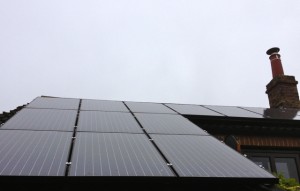Perovskite.
It took from the early 1960s until just a few years ago for the conventional solar panel to get about as far as is going to go with current technology, where panels, made up of silicon-based solar cells, can turn 20-22% of the energy in sunlight into electricity.
So that’s about 50 years.
Scientists only started working seriously with perovskite solar cells – the basis for what is being called the next generation of solar panels – in 2009. Working at the same timescale, this form of renewable energy generation will be at peak efficiency in about 2060. Hardly the answer to climate change.
Others are more sanguine, suggesting it might only be 10 years before perovskite panels begin to make a difference. But even if that cautious prognosis is borne out, we could still be in for some interesting, if not dramatic, advances in renewable energy around about the time when the Hinckley C nuclear power station starts generating energy. And that is assuming the project gets a quick decision and everything goes to plan,
So what is perovskite, and should we get excited about it? Solar cells using different types of perovskite made their debut in 2009. In essence, the cells are based on a kind of crystal that can be easily made in the laboratory, unlike the silicon used in the manufacture of conventional PV solar panels. It should lead to the production of cheaper and more efficient panel.
The advantage of conventional photovoltaic (PV) panels is that they are robust, stable in their performance and built to last, and they do just that. Some, developed at the very start of the technology, are still working. The ones you see on rooftops today are likely to be good for 20 years or more, by which time many of them would have paid for themselves several times over.
Perovskite panels are different. The crystals they are made up of degrade in the presence of light and humidity. Hardly an indicator of longevity. However, scientists are working to both develop the technology and address these problems at universities and institutions around the world.
More resilient
And researchers already appear to have some answers. According to scientists at the Los Alamos National laboratory, it seems that a type of more resilient perovskite crystals can regenerate or “self heal” themselves after a short period in the dark. The Los Alamos team hopes to have a working prototype made from this type of cell by the end of 2016, capable of 18% efficiency, not far short of the around 20% figure achieved by conventional silicon cells.
Other scientists, working at the Okinawa Institute of Science and Technology University, discovered something else: that if the perovskite panels were exposed to just the right amount of moisture, their electrical properties were noticeably enhanced.
Another research team working in a Shanghai University have demonstrated a method for “growing” crystals, which can be used to create perovskite solar cells with greater stability, fewer defects and better efficiency.
Advances
In the early days of perovskite development, in 2009, researchers were achieving a power conversion efficiency (PCE), the standard measure of a solar panel’s performance, of just 3%. Today that figure is already more than 20%. So in six years scientists have made advances which it took their colleagues in the field of conventional solar cells 50 years to accomplish.
We had solar panels installed of our home late in 2011, and they’ve operated smoothly ever since, delivering us regular cheques from the government through the Feed In Tariff system.
When they were fitted I wondered whether they would still be there in 20 years, or whether some new technology would take their place. At that time I had never heard of perovskite and the research was in its infancy.
Even if it does take a further 10 years for perovskite panels to come to anything, I could still be in the position to swap my panels for something cheaper and more efficient well within the timescale I was given for those old-technology panels. But with so many universities and research institutes working on this, I have a feeling there will be be exciting developments well before that date.

